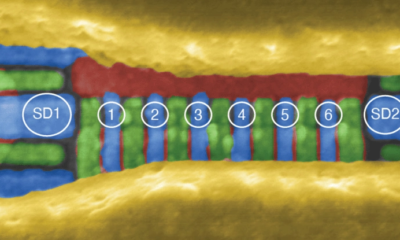Emerging Tech
Quantum Physicists Set New Record For Entangling Photons Together

A new method for entwining the fates of fragments of light has overcome some serious obstacles on the road to photon-based quantum computing.
Researchers from the Max Planck Institute of Quantum Optics in Germany have successfully entangled 14 photons into a state considered optimal for qubits, more than doubling previous attempts – while also improving their efficiency.
Unlike the ‘bits’ of binary code behind more conventional forms of computing technology, qubits exist in a state of probability called a superposition, behaving like a flipped coin as it tumbles through the air.
Algorithms based on the way groups of quantum coins fall can make short work of some pretty complex mathematics, but only if their collective spinning isn’t unwittingly blown off course by the environment.
Referred to as decoherence, this interruption to a particle’s superposition is a huge hurdle for engineers designing useful quantum computers.
In theory, just about anything can exist in a quantum superposition of states, from electrons to atoms to whole molecules (or bigger). But to limit decoherence, smaller and simpler objects take the cake.
Photons make ideal qubits. Unfortunately, practical quantum computers need a lot of qubits. Thousands. Millions even. The more, the better. Not only do they all need to be spinning in superposition at once, but their fates also have to be shared. Or, to use the physics term, entangled.
This is where the challenge comes in.
There are relatively easy ways to entangle pairs of photons. Force an atom to emit a wave of light and then split it using a special screen, and you’ll get two photons with a shared history.
While they remain in flight with their respective characteristics, yet to be measured, they more or less act like that spinning coin. Eventually, one will come up heads, and the other tails.
Entangling more than two photons becomes more of a challenge.
Experiments with objects called quantum dots have managed to entangle chains of three to four photons. Not only is it unlikely to ever produce the hundreds and thousands needed for a quantum computer, but the state of entanglement using this approach also isn’t as reliable as engineers might like.
More recent studies using atoms with large electron orbits, called Rydberg atoms, have produced up to six entangled photons, all in an efficient entangled form. Though the method could make for super-fast computing components, it isn’t an easily scalable option either.
This newest solution could, in theory, produce any number of entangled photons, all in the ideal state.
“The trick to this experiment was that we used a single atom to emit the photons and interweave them in a very specific way,” says physics doctoral student and lead author Philip Thomas.
An atom of rubidium was tickled into emitting light waves, which were channeled into a cavity shaped to reflect them back and forth in a very precise manner.
By perfectly fine-tuning the way the rubidium glowed, each photon could be entangled with the entire atom’s state – meaning each photon bouncing back and forth in the cavity was entangled with a significant number of its siblings as well.
“Because the chain of photons emerged from a single atom, it could be produced in a deterministic way,” says Thomas.
In this case, the team managed to entangle 12 photons in a less efficient linear cluster, and 14 in the prized Greenberger–Horne–Zeilinger (GHZ) state.
“To the best of our knowledge, the 14 interconnected light particles are the largest number of entangled photons that have been generated in the laboratory so far,” says Thomas.
Not only were they able to entangle so many photons, the efficiency of this method improved on past processes, with nearly one out of every two photons providing neatly entangled qubits.
Future setups will need to introduce a second atom to provide the qubits necessary for many quantum computing operations. Having entangled photons on tap could provide the foundations for technology beyond computing, occupying a central role in quantum encrypted communications.
This research was published in Nature.
Source: https://www.sciencealert.com/quantum-physicists-set-new-record-for-entangling-photons-together







